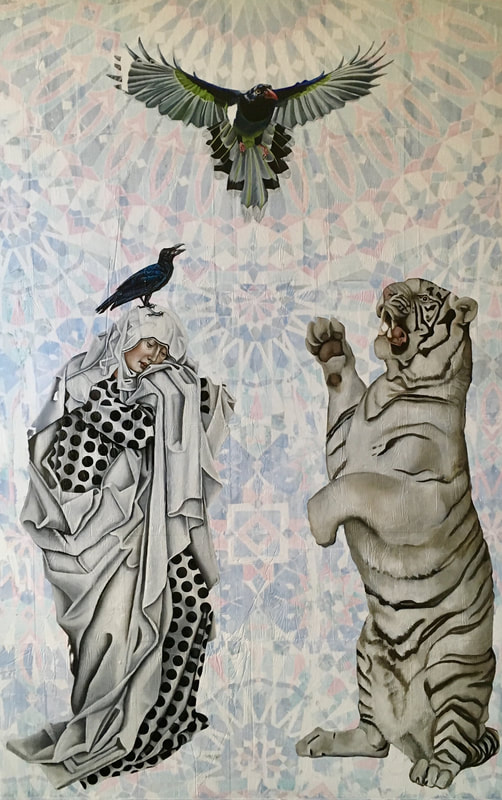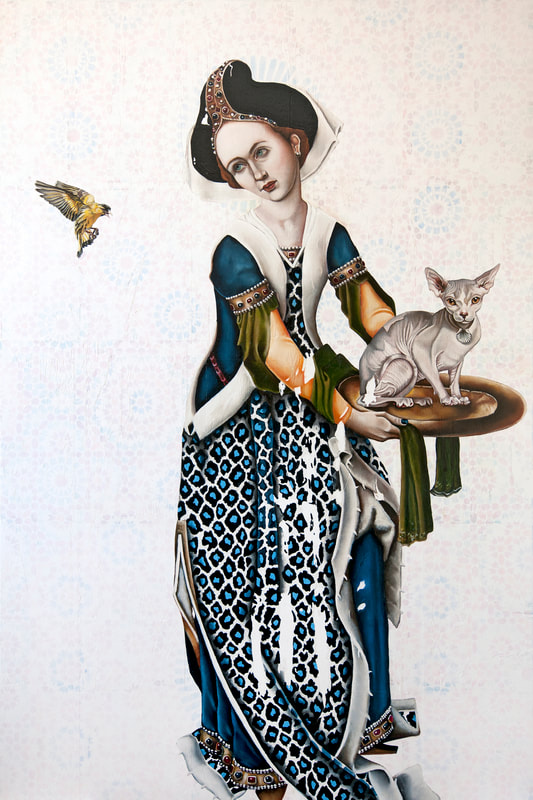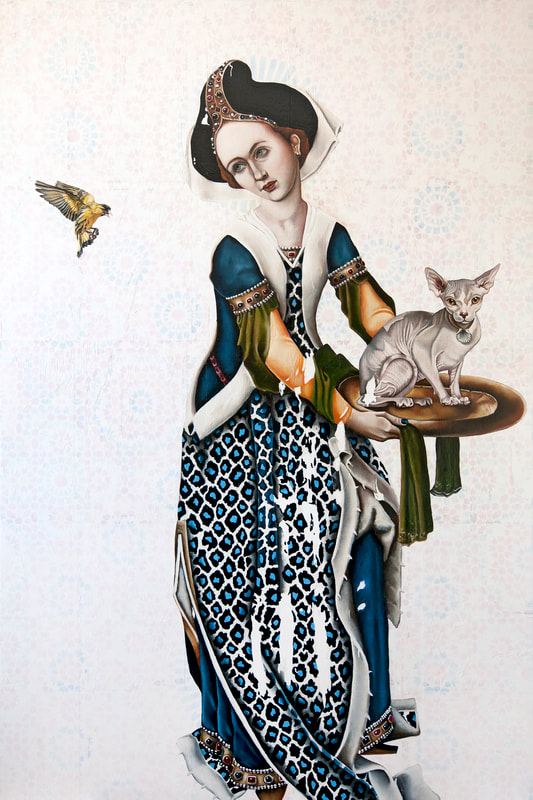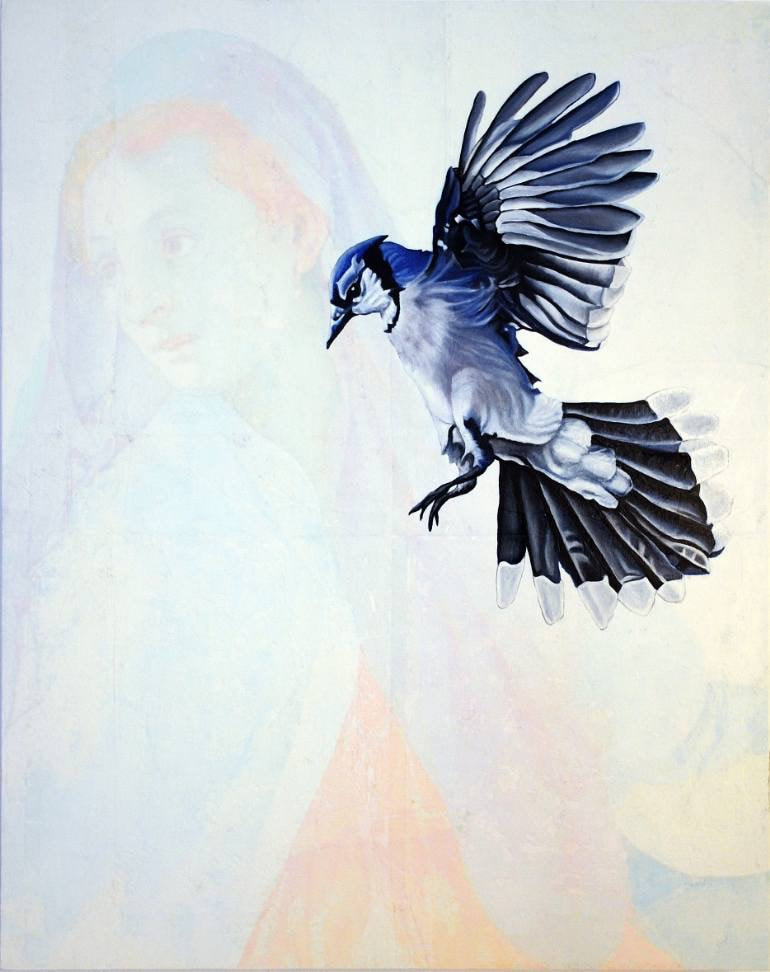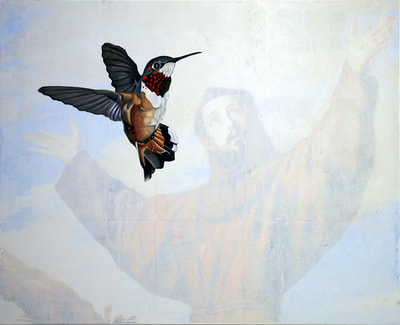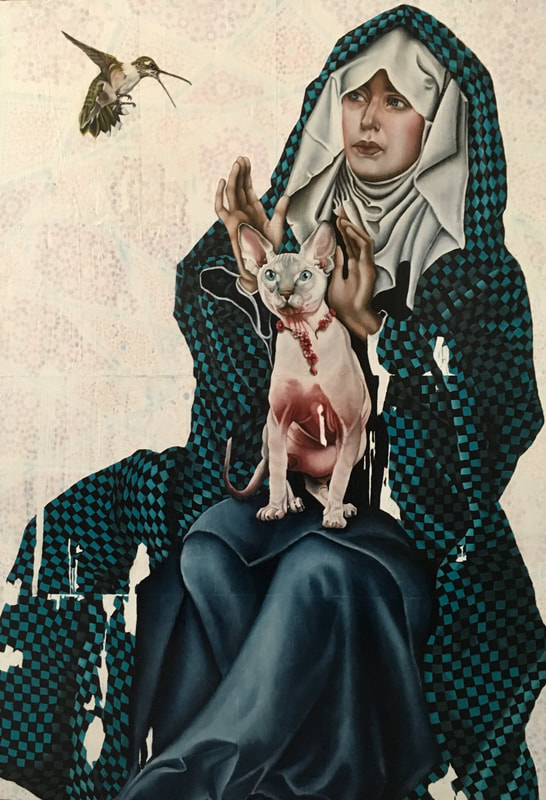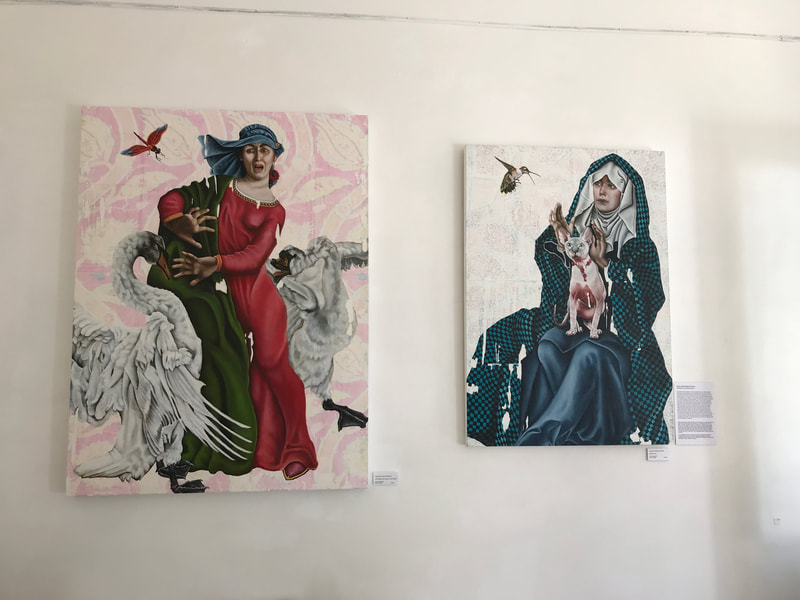RENAISSANCE REIMAGININGS
Paintings by Leslie Glenn Damhus, RWA Elect
April 2018
Lane House Arts, Bath
Lane House Arts is thrilled to present Renaissance Reimaginings, a solo of show of paintings by Leslie Glenn Damhus, her second exhibition in our Bath gallery.
My creative practice reflects my interest in Renaissance Art, fables, myths and spiritual tales. Appropriating the work of Renaissance artists, I look to blur the lines between the historic and the contemporary. Often, symbolism in devotional imagery is playful. I strive to reflect this in my own work.
What allegorical secrets are contained in fruit, or plants, or in the animals themselves? I am also interested in the double meanings of animal symbolism: how a bird, for example, may signify a prophet in one painting and the Devil in another, or both at once, suggesting that nature can be simultaneously serene and menacing. Subtle contemporary fabrics play another important role: swaddling clothes, or the Virgin’s dress are patterned in polka dots, stripes or bubble gum tones of yellow, pink and blue urban camouflage. Haloes become flowers or decorative plates and knitted animal hats reflex social movements.
My oil paintings are made on wooden panels with attention to details. I am interested in the patterns, textures and finishes that come from the printing process that is applied to create the work. This paradoxical combination of multi-layered fine detail oil techniques with the ‘look’ of old fresco paintings allows for an element of control but also an element of chance at the same time. By bringing the richness of sacred imagery into the contemporary art space, I am expressing my own sense that such imagery is still somehow relevant to modern life.
In keeping with Renaissance custom, Glenn Damhus’ paintings capture the spirit of how symbolism is adaptive to changing social values. The playful signs and symbols in her Marian portraits represent concepts that remain, even today, in our supposedly secular society, sacred and wonderful.
Read more about the artist here
Click here to see Renaissance Menagerie, Leslie's first exhibition with Lane House Arts at our gallery in Bath from December 2016 to February 2017
Click here to see Renaissance Menagerie, Leslie's first exhibition with Lane House Arts at our gallery in Bath from December 2016 to February 2017
ONE FOR SORROW
oil on board 2017 90cm x 140cm (Sold)
Rogier van der Weyden’s Crucifixion, from the Monastery of San Lorenzo del Escorial ca. 1457-64, became the starting point of my painting One for Sorrow. I was attracted by the grandeur of this huge crucifixion with its purity of colour and the expressiveness of the main characters. A large vermilion coloured cloth hangs behind the three main figures. It is exquisitely painted, revealing how the cloth was folded before it was hung. The square repetitive patterns of the cloth reminded me of the faint lines I create when applying the background stage of my paintings. I began to explore the beautiful patterns found in Islamic mosques, searching for designs that would work best with the imagery I was trying to create.
The mosaic pattern from the Hassan II Mosque was the perfect match with its hues of ultramarine, emerald greens and burnt sienna. I appropriated the female figure - her head bent down, crying into the white outer wrap that engulfs her. Her inner dress is covered with large black polka dots. A crow, the symbol of the Great Goddess, sits upon her head looking above. His mouth is open. Is he the reason for her tears? Facing her, a sacred white tiger stands up on his hind legs, not unlike the figure of the man in the original painting by van der Weyden, hands in the air, head looking up. He is strong and powerful and represents the protector who drives away the evil spirits. Above them all, the magpie hovers, wings spread out in all its glory. He is a Taiwanese Blue magpie, exotic and magnificent in colour.
Researching magpies led me to the traditional children's nursery rhyme and the title of the painting. In Britain, the rhymes go back to the sixteenth century. However, in Piero della Francesca’s painting Nativity ca.1472-1474, a single magpie is perched on a rooftop of an unfinished manger, perhaps presaging sorrow for Mary.
ONE FOR SORROW
oil on board 2017 90cm x 140cm (Sold)
Rogier van der Weyden’s Crucifixion, from the Monastery of San Lorenzo del Escorial ca. 1457-64, became the starting point of my painting One for Sorrow. I was attracted by the grandeur of this huge crucifixion with its purity of colour and the expressiveness of the main characters. A large vermilion coloured cloth hangs behind the three main figures. It is exquisitely painted, revealing how the cloth was folded before it was hung. The square repetitive patterns of the cloth reminded me of the faint lines I create when applying the background stage of my paintings. I began to explore the beautiful patterns found in Islamic mosques, searching for designs that would work best with the imagery I was trying to create.
The mosaic pattern from the Hassan II Mosque was the perfect match with its hues of ultramarine, emerald greens and burnt sienna. I appropriated the female figure - her head bent down, crying into the white outer wrap that engulfs her. Her inner dress is covered with large black polka dots. A crow, the symbol of the Great Goddess, sits upon her head looking above. His mouth is open. Is he the reason for her tears? Facing her, a sacred white tiger stands up on his hind legs, not unlike the figure of the man in the original painting by van der Weyden, hands in the air, head looking up. He is strong and powerful and represents the protector who drives away the evil spirits. Above them all, the magpie hovers, wings spread out in all its glory. He is a Taiwanese Blue magpie, exotic and magnificent in colour.
Researching magpies led me to the traditional children's nursery rhyme and the title of the painting. In Britain, the rhymes go back to the sixteenth century. However, in Piero della Francesca’s painting Nativity ca.1472-1474, a single magpie is perched on a rooftop of an unfinished manger, perhaps presaging sorrow for Mary.
SALOME WITH CAT AND BIRD
oil on board 2017 80cm x 120cm
The story of Salome has long been a favourite amongst artists. Exploring Rogier van der Weyden’s The Altar of St. John, I was immediately attracted to his portrayal of Salome. Her lavish headdress adorned with pearls and jewels and the ermine edged cloth epitomises the style of the Renaissance. In my version, I combined the elaborate seductive decorations of van der Weyden’s dress and added a contemporary blue leopard skin print fabric.
Changing the original narrative is something I do regularly in many of my paintings. Salome has long been depicted as the symbol of the dangerous femme fatale, famously dancing her seductive dance and bringing the head of John the Baptist on a platter to her mother. But here on her golden platter she displays, not the head of The Baptist but a hairless cat, looking cold and somewhat annoyed.
Does he represent our pet-obsessed culture in today's social media? He wears the necklace of a half scallop shell, one of the symbols of The Baptist but Instead of him wrapped in his hallmark animal-skin tunic, Salome now wears the fur of an animal, a synthetic fabric of our time. A small American goldfinch hovers near them, screaming out. But who is her anger vented at? Who is the villain of this strange tale?
oil on board 2017 80cm x 120cm
The story of Salome has long been a favourite amongst artists. Exploring Rogier van der Weyden’s The Altar of St. John, I was immediately attracted to his portrayal of Salome. Her lavish headdress adorned with pearls and jewels and the ermine edged cloth epitomises the style of the Renaissance. In my version, I combined the elaborate seductive decorations of van der Weyden’s dress and added a contemporary blue leopard skin print fabric.
Changing the original narrative is something I do regularly in many of my paintings. Salome has long been depicted as the symbol of the dangerous femme fatale, famously dancing her seductive dance and bringing the head of John the Baptist on a platter to her mother. But here on her golden platter she displays, not the head of The Baptist but a hairless cat, looking cold and somewhat annoyed.
Does he represent our pet-obsessed culture in today's social media? He wears the necklace of a half scallop shell, one of the symbols of The Baptist but Instead of him wrapped in his hallmark animal-skin tunic, Salome now wears the fur of an animal, a synthetic fabric of our time. A small American goldfinch hovers near them, screaming out. But who is her anger vented at? Who is the villain of this strange tale?

